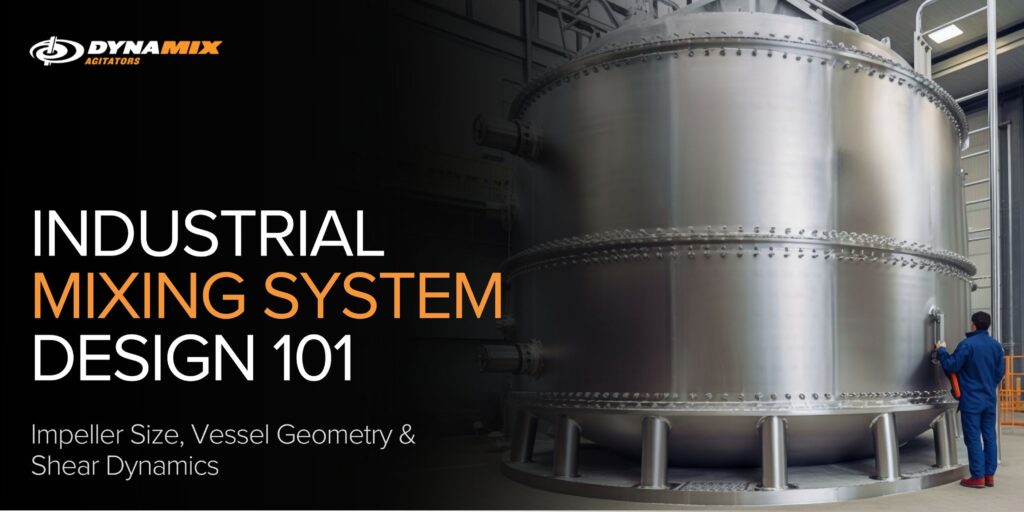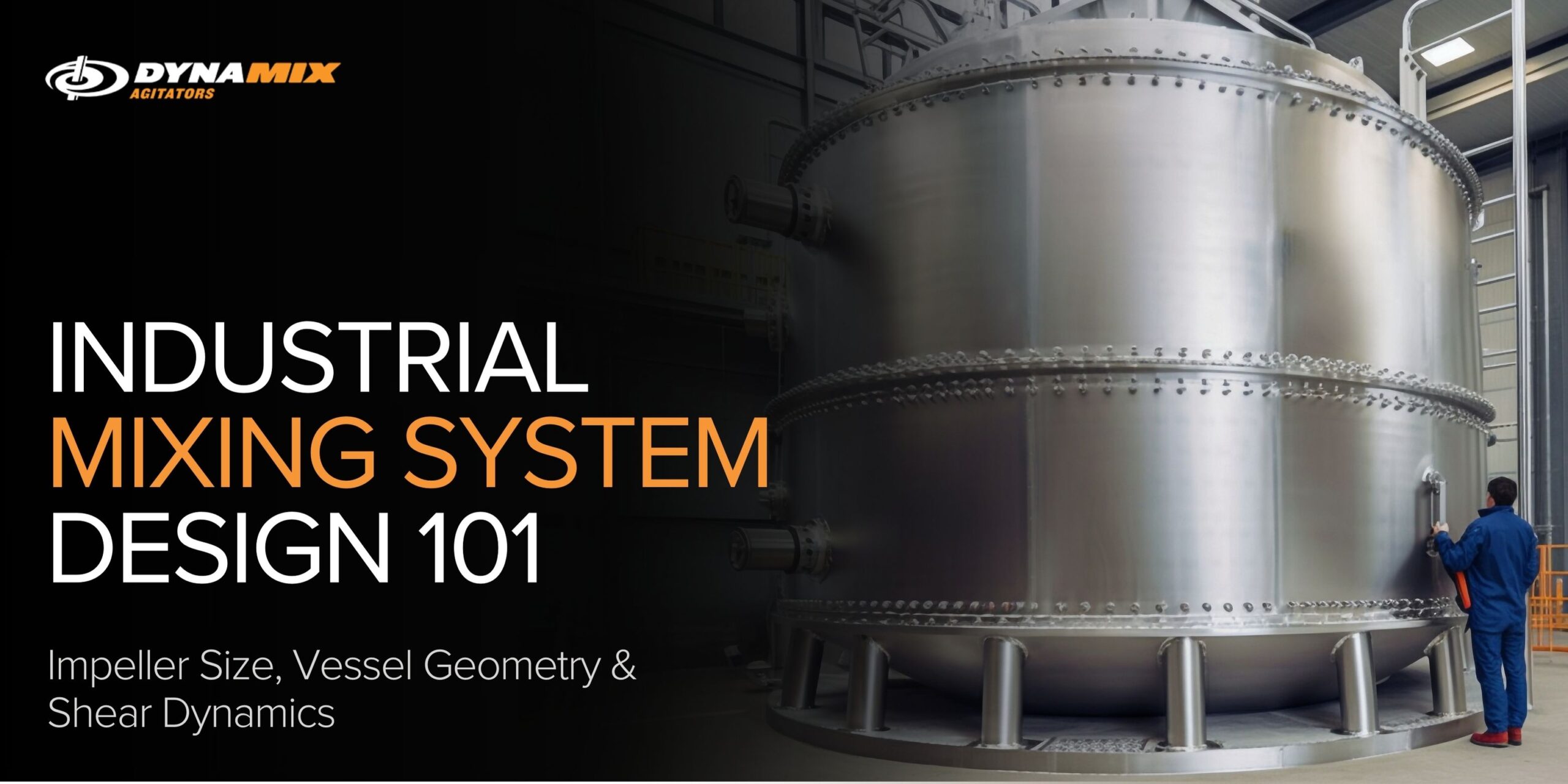- Q: How do I choose the right impeller size for my tank?
A. Base it on tank diameter and fluid properties. A common rule is 1/3 to 1/2 the tank diameter.
- Q: What tank shape is best for mixing?
A: Cylindrical tanks with baffles are most common. Cone bottoms are ideal for solids discharge.
- Q: How does vessel geometry affect mixing?
A: It influences flow patterns, power requirements, and the risk of dead zones.
- Q: When should I use high-shear mixing?
A: When blending immiscible fluids, dispersing particles, or emulsifying ingredients.
Industrial Mixing System Design 101: Impeller Size, Vessel Geometry & Shear Dynamics
Why Understanding Mixing System Design Is Crucial
Industrial mixing isn’t just about selecting a motor or choosing an impeller. True system optimization requires a deep understanding of the interplay between impeller size, vessel geometry, and shear dynamics. Whether you’re mixing low-viscosity solvents or high-solids slurries, the performance of your mixing system depends on balancing these core variables.
This blog serves as a comprehensive guide to the essential design principles behind high-performing industrial mixing systems.

P = Np x 𝜌 x N3 x D5
Where:
-
-
- P = power required (W)
- Np = power number (based on impeller type
- 𝜌 = fluid density (kg/m3)
- N = impeller speed (revolutions per second)
- D = impeller diameter (m)
-

Tank Geometry: Shape Affects Flow Pattern
The geometry of the mixing vessel plays a critical role in how fluid moves within it. Common tank configurations include:
Cylindrical Tanks: Promote even radial flow and are standard across industries.
Conical Bottoms: Help prevent solids accumulation and improve drainage.
Rectangular Tanks: Can create dead zones if not properly baffled.
Baffles are key design elements that prevent vortex formation and encourage top-to-bottom circulation. Typically, four baffles are installed vertically at 90-degree intervals.

Shear Dynamics: Managing Material Breakdown and Blending
Shear refers to the differential velocity across fluid layers. It’s essential for breaking down particles, emulsifying liquids, or dispersing solids. However, excessive shear can damage sensitive components such as polymers or biological materials.
High Shear: Achieved with high-speed impellers like rotor-stators or saw-tooth blades. Used in emulsions, polymer mixing, or cosmetic creams.
Low Shear: Paddle, anchor, or hydrofoil impellers are better suited for delicate materials or bulk blending.
The Interaction of Variables: Designing a Balanced System
Choosing the right impeller without considering vessel geometry or shear requirements can lead to underperforming systems. Successful designs factor in:
Reynolds Number (Re): Indicates laminar vs. turbulent flow
Tip Speed: — critical for understanding shear impact
Viscosity & Specific Gravity: Affect torque, power, and flow regime
Customization at Dynamix Agitators: Engineering Beyond the Basics
At Dynamix Agitators, we understand that no two mixing systems are alike. That’s why our design process includes:
CFD modeling to predict fluid flow and shear distribution
Impeller testing for various tank shapes and baffle configurations
Motor and gearbox pairing based on torque and power demands
Dynamix leverages decades of expertise to deliver tailored mixing solutions for industries ranging from wastewater to food and beverage to petrochemicals.

Case Applications Across Industries
Pharmaceutical Blending: Requires low-shear impellers and hygienic designs to protect active ingredients.
Water Treatment: Needs full-tank circulation and minimal dead zones.
Paint & Coatings: Demands moderate shear and high flow to disperse pigments.
Chemical Processing: Often involves high-torque mixing under pressure or heat.
Review more application strategies at events like
Conclusion: Designing for Success Starts with Fundamentals
The best mixing systems aren’t assembled—they’re engineered. By understanding how impeller size, vessel geometry, and shear dynamics interrelate, you can design mixers that meet both process and operational goals.
Collaborating with a partner like Dynamix Agitators ensures that your mixing system is not only technically sound, but customized for your industry, fluid type, and production environment. Give our in-house Application Engineers the details of your build on our form and we can get back to you with pricing and solutions.
FAQ's

Environmental Factors To Consider When Designing a Mixer
Why Environment Matters in Mixer Designs In the industrial

Mixing Non-Newtonian & High-Viscosity Fluids: Strategies for Shear, Temperature & Rheology Control
Understanding the Complexity of Non-Newtonian and High-Viscosity Fluid Mixing Mixing

Industrial Mixing System Design 101: Impeller Size, Vessel Geometry & Shear Dynamics
Why Understanding Mixing System Design Is Crucial Industrial mixing
Other Recent In The Mix Articles:
Search :
SELECT THE BLOG CATEGORY BELOW
Categories
- Coal Mining (1)
- Crop Protection (1)
- Dynamix Products (7)
- Explosion Proof Motors (1)
- Fertilizer Mixer (1)
- Hand Sanitizers (1)
- Industrial Mixing (51)
- Mechanical Seals (1)
- Mining & Mineral Processing (1)
- Mixer Configuration (25)
- Mixing 101 (23)
- Mixing at Home (5)
- Mixing Principles in Play (9)
- Oil & Gas (1)
- Tank Configuration (4)
- Tote Mixing (2)
- Update (1)
- Water Treatment (28)
- Water Treatment Books (6)
- Water Treatment Innovation (13)
WHAT OUR CUSTOMERS ARE SAYING
Keep up with what's new at Dynamix
Subscribe to our newsletter for helpful technical publications and industry announcements.


